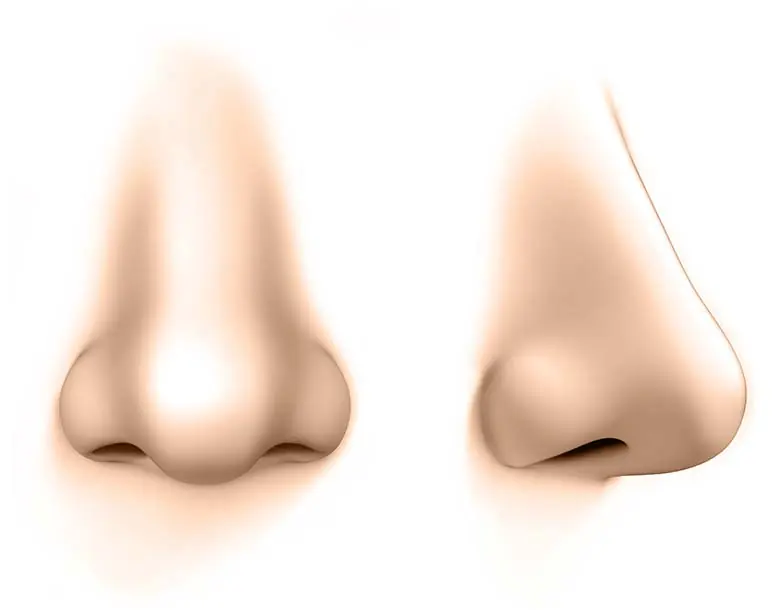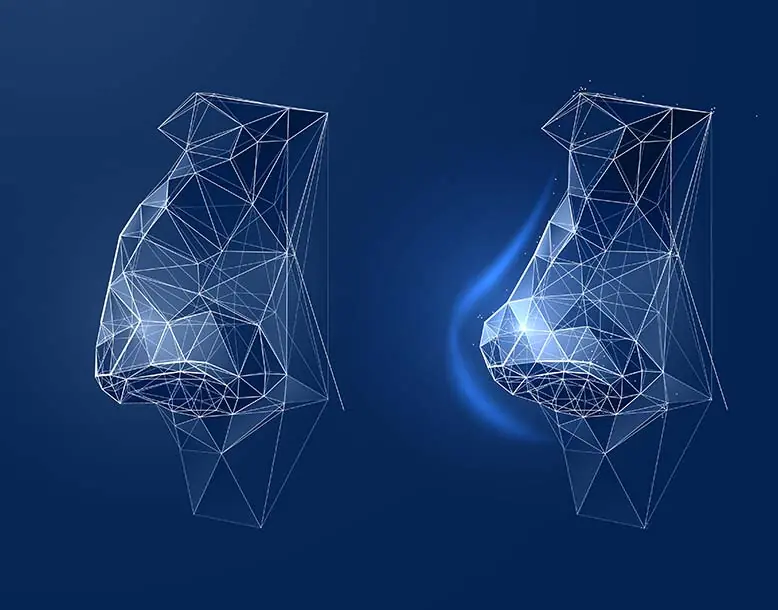medical rhinoplasty, or rhinoplasty without surgery, est une technique innovante qui permet de corriger les imperfections du nez sans intervention chirurgicale. Grâce aux injections d’hyaluronic acid, il est possible de remodeler le nez, d’atténuer une bosse, de redresser une pointe ou d’améliorer la symétrie de manière rapide et indolore. Ce traitement, dont le résultat n’est pas permanent et est ajustable, est une option idéale pour les patients qui souhaitent modifier leur nez sans avoir recours à une surgical rhinoplasty.
A medical rhinoplasty in Geneva can transform your profile with natural, immediate results and without social eviction.
Il est possible de corriger certains défauts du nez grâce aux injections d’acide hyaluronique. Cependant, il est essentiel de comprendre que la rhinoplastie médicale ne permet pas de « refaire » son nez comme le ferait une intervention chirurgicale. En médecine esthétique, l’acide hyaluronique agit par un effet de compensation volumétrique : il permet de corriger certains défauts de relief, d’harmoniser les lignes anatomiques et de lumière du nez. Ainsi, il peut atténuer une bosse, combler un creux ou améliorer la projection du nez, remonter la pointe sans modifier sa structure osseuse ou cartilagineuse. Cette technique s’adresse donc à des corrections précises, lorsque les attentes du patient sont réalistes et compatibles avec une approche médicale.
L’acide hyaluronique permet de modifier légèrement le nez en jouant sur les volumes. Il ne change pas la structure du nez, mais aide à en améliorer l’harmonie. Après une rhinoplastie médicale, le nez peut sembler plus droit, plus régulier et mieux proportionné par rapport au reste du visage.
Le produit peut aussi apporter un léger soutien à certaines zones, comme l’arête du nez ou la pointe, lorsque cela est indiqué. Les résultats sont visibles immédiatement après l’injection. Un léger gonflement peut apparaître au début, puis disparaître progressivement. Les résultats ne sont pas définitifs : ils sont temporaires, ce qui permet d’ajuster le traitement au fil des séances si nécessaire.
Après une injection d’acide hyaluronique au niveau du nez, il est important d’éviter toute pression sur la zone traitée. Il est donc recommandé de dormir sur le dos, avec la tête légèrement surélevée, afin de limiter le gonflement et de ne pas déplacer le produit.
Il est préférable d’éviter de dormir sur le côté ou sur le ventre pendant les premières nuits, le temps que l’acide hyaluronique s’intègre correctement. Ces précautions simples contribuent à la sécurité du traitement et à un meilleur résultat esthétique.

The ideal nose possesses the following characteristics :

There are twelve main types of nose.
Le nez duchesse est considéré comme l’un des plus beaux nez en raison de sa forme droite. Il a été représenté dans de nombreuses œuvres d’art, ce qui lui a conféré un statut d’idéal de beauté=.
La rhinoplastie médicale du nez asiatique tient compte des particularités anatomiques spécifiques, comme une arête nasale souvent peu marquée et des cartilages plus souples. En médecine esthétique, l’objectif n’est pas de transformer l’identité ethnique, mais d’améliorer l’harmonie du visage en respectant les traits naturels.
L’injection d’acide hyaluronique permet d’augmenter la projection et d’équilibrer le profil, sans avoir recours à la chirurgie. Cette approche demande une bonne connaissance des structures du nez asiatique afin d’éviter des résultats standardisés et de préserver l’expression naturelle du visage.
La rhinoplastie médicale du nez ethnique s’adresse à des morphologies variées, comme les nez africains, moyen-orientaux ou métissés. Ces nez présentent souvent une arête nasale peu marquée ou une transition front-nez plus prononcée.
L’acide hyaluronique permet d’améliorer le nez en travaillant sur les volumes et les lignes, afin de les rendre plus harmonieuses. L’objectif n’est pas de gommer les traits ethniques, mais de les mettre en valeur de façon subtile et naturelle.
Chaque traitement est personnalisé, car la forme du nez et les attentes varient d’une personne à l’autre.
La rhinoplastie médicale de la pointe du nez permet, dans des indications précises, d’améliorer la projection ou la définition de la pointe du nez. Elle s’adresse aux patients présentant une pointe peu marquée ou légèrement affaissée. L’acide hyaluronique peut apporter un soutien discret et améliorer le profil, à condition que l’indication soit rigoureusement posée. Cette zone nécessite une extrême prudence en raison de son anatomie vasculaire, ce qui fait de ce traitement un acte strictement médical, réservé à des corrections légères et maîtrisées.
Un nez creusé peut être lié à la forme naturelle du nez, au vieillissement ou à une chirurgie réalisée auparavant. La rhinoplastie médicale par injection d’acide hyaluronique permet de combler certains creux au niveau de l’arête du nez afin de retrouver un dorsum plus régulier et harmonieux.
L’objectif est de corriger l’aspect creusé sans alourdir le nez, tout en respectant les proportions du visage. Cette indication est fréquente en médecine esthétique et donne de bons résultats lorsqu’elle est réalisée avec des quantités précises et un produit adapté à cette zone.
La rhinoplastie médicale peut, parfois, être réalisée sur un nez déjà opéré lorsqu’il reste des irrégularités, des asymétries ou des creux. Elle ne remplace pas une nouvelle chirurgie, mais peut permettre d’améliorer le nez sans avoir recours à une intervention plus lourde.
Après une chirurgie, le nez est plus fragile et son anatomie a été modifiée. Une évaluation attentive est donc indispensable avant tout traitement. L’acide hyaluronique est alors utilisé avec beaucoup de précautions, uniquement pour des corrections ciblées.
Le nez occupe une position centrale sur le visage, influençant directement l’équilibre et la symétrie des traits. Sa forme et sa taille contribuent à l’esthétique générale et à l’expression faciale.
Un nez équilibré présente des proportions harmonieuses avec le reste du visage, une arête droite ou légèrement concave, une pointe bien définie et des narines symétriques. Les angles entre le nez et le front, ainsi qu’entre le nez et la lèvre supérieure, jouent également un rôle clé dans l’esthétique nasale.
Avec l’âge, la peau du nez peut perdre de son élasticité, la pointe peut s’affaisser légèrement et des imperfections peuvent devenir plus prononcées, modifiant ainsi l’aspect du nez.
Les défauts fréquemment corrigés incluent une bosse sur l’arête nasale, une pointe tombante ou trop large, une asymétrie ou des irrégularités de la surface nasale.
Les caractéristiques nasales varient selon les origines ethniques. Par exemple, certaines personnes peuvent présenter des nez plus larges ou des arêtes plus plates. Ces spécificités sont essentielles à considérer pour des traitements esthétiques adaptés.
La rhinoplastie médicale, par injections d’acide hyaluronique, permet de corriger des imperfections mineures du nez sans recourir à la chirurgie. Cette technique offre une alternative non invasive avec des résultats immédiats.